

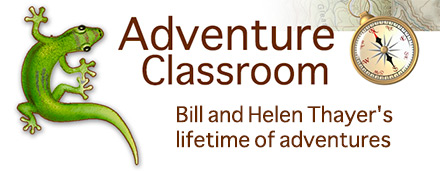
DEATH VALLEY NATIONAL PARK
Unless otherwise noted, photos (c) Helen Thayer
Death Valley is America’s lowest, hottest, and driest National Park, and the largest south of Alaska. After being declared a National Monument in 1933 Death Valley was later substantially expanded to over 3.4 million acres of desert and mountains for hiking, camping and biking. It became a National Park on October 31, 1994 and is managed by the National Park Service.
Helen Describes Her Death Valley Crossing [Page One]
Death Valley is most well known for being one of the hottest places on earth. On July 10, 1913, the United States Weather department recorded a high temperature of 134 °F at Furnace Creek in Death Valley. This temperature stands as the highest ambient air temperature ever recorded at the surface of the Earth. (A report of a temperature of (136.4 °F) recorded in Libya in 1922 was later determined to be inaccurate.) Death Valley also holds the highest recorded natural ground surface temperature on earth at 201 °F recorded on July 15, 1972.
THE DESERT
Mountain ranges act as barriers to the flow of air across the surface of the earth. When warm air travels from a low valley region to the foothills of a mountain range, it is forced to rise up and over the mountains. As the air is lifted up the mountain slope, it cools as it rises and often results in the formation of clouds and eventually precipitation, which falls as rain on the windward slope. The windward side is that side which faces the prevailing wind (upwind), whereas the leeward, or "lee" side is the side sheltered from the wind by the mountain's elevation (downwind).
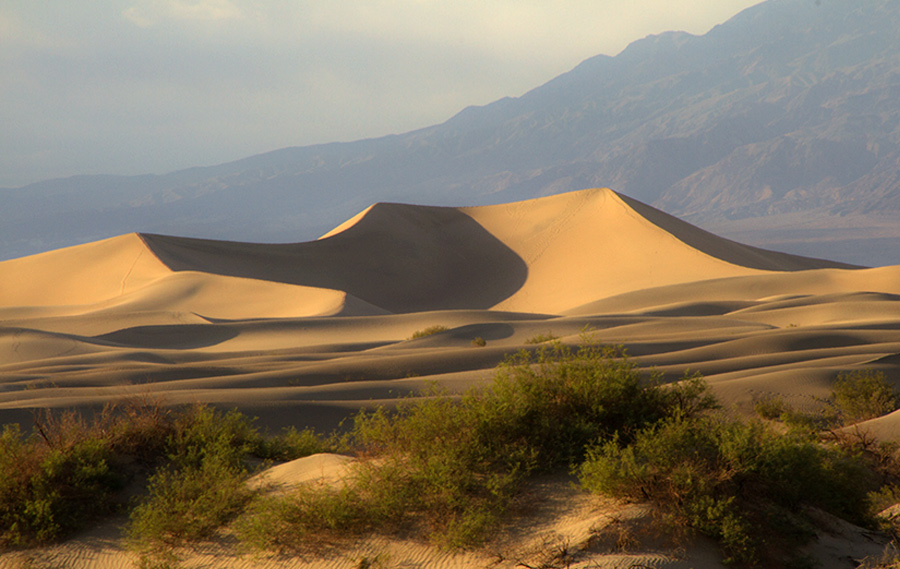
Majestic sand dunes
In contrast to the moist windward side of a mountain, the leeward side typically has a dry, warm climate. This is because by the time air rises up the windward side and reaches the summit, it has already been stripped of the majority of its moisture. As this dry air descends down the leeward side, it warms and expands which causes clouds to dissipate and further reduces the possibility of precipitation. This occurrence is known as the rain shadow effect. It is the reason why locations at the base of a mountain on the leeward side are often some of the driest places on Earth. Death Valley is a rain shadow desert. Four major mountain ranges lie between Death Valley and the ocean, each one adding to an increasingly drier rain shadow effect, and in 1929, 1953, and 1989, no rain was recorded in Death Valley for the entire year.
GEOLOGY
Death Valley has a very long and complex geologic history. Its most ancient rocks are over 1.8 billion years old, while the youngest are still forming. Over centuries they have been changed in every possible way and severely sliced by erosion. The mountains are constantly eroding; their remains spill out into the valley to form the enormous alluvial fans that spread like aprons at the mouth of every canyon. Erosion has formed the largest alluvial fans in the world.
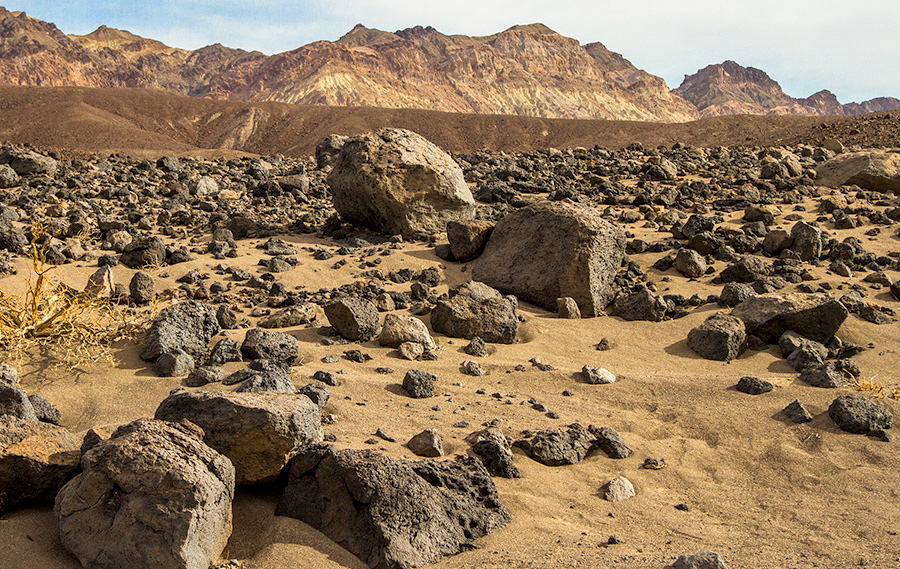
Rock and boulders scattered about
Geology has shaped the natural environment of Death Valley making it an excellent example of a graben, that is, a rift valley formed by the sinking of the bedrock lying between parallel, uplifted, mountain ranges. In Death Valley the two mountain ranges are the Amargosa to the east and the Panamints to the west. The present landscape was shaped between 5 million and 35 million years ago, during the Cenozoic Era. After faults formed in the earth's crust, extraordinary folding and volcanic action uplifted the surrounding mountain ranges and lowered the valley floor, creating a graben. The present valley floor is still dropping on one side and is actually 8,000 to 10,000 feet above its bedrock base. Intervening space is filled by the massive amount of debris eroded from the surrounding mountains over time. The valley floor is still slowly dropping and the mountains on each side are gradually rising
Death Valley is valued as a geological classroom. Due to erosion, rocks are being constantly exposed. The rocks in one mountain range are often totally different to the rocks situated only a few miles away. Rocks sometimes separated only by inches can vary in age by a billion years. Historical earthquakes and violent volcanic action have raked the earth's surface while Ice Age lakes filled the valley with water hundreds of feet deep. Wind has had a profound effect as it formed sand dunes in some areas and in others, stripped the land surface bare of soil.
A violent steam explosion caused by magma rising to the surface and volcanically heating ground water that instantly flashed into a gigantic steam explosion creating a great hole stretching 2,000 feet across and 700 feet deep caused Ubehebe Crater. It is thought to have occurred more than 300 years ago. The surrounding countryside was covered in 150 feet of ash and cinders from this explosion and several other smaller explosions.
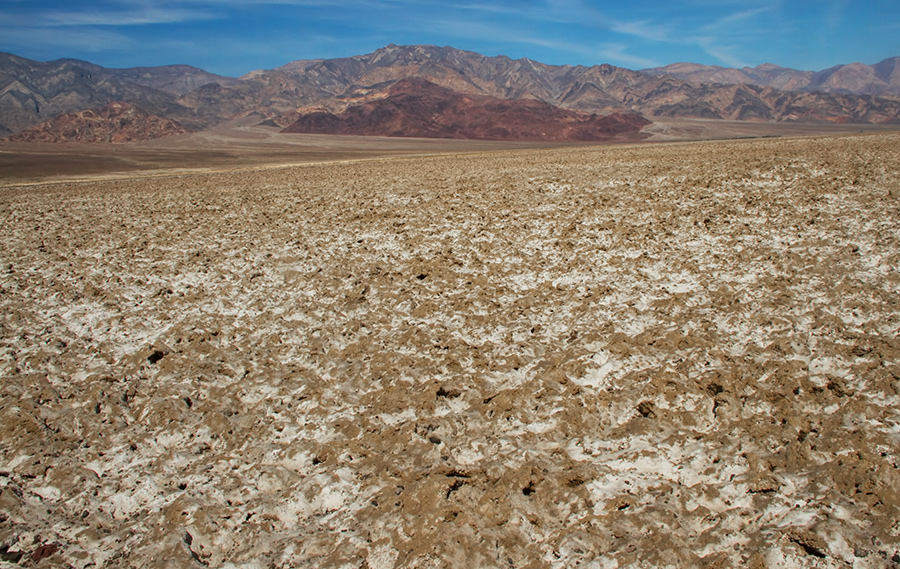
Salt beds cover a lot of the valley
Lake Manly, an Ice Age lake, 100 miles long and 600 feet deep, covered much of the valley floor. Around 10,000 years ago as the area turned to desert, the water evaporated, leaving an abundance of evaporated salts such as common sodium salts and borax, which were later commercially exploited during the region's modern history, primarily from 1883 to 1907. The Devils Golf Course is a salt and silt layer 1,500 feet thick.
Death Valley's Badwater Basin is the point of the lowest elevation in North America, at 282 feet below sea level. An unknown prospector who was exploring the area in search of minerals named it. According to his account, when he reached the pools of water in Death Valley (now Badwater), the water was so foul that his mule refused to drink it despite the extreme heat. He immediately named the pool of water “Badwater", a name that has persisted through time.
CLIMATE
Death Valley has a hot desert climate with long, extremely hot summers and short, mild winters, as well as little, and some years, no rainfall. During the day the sun heats the ground and the air trapped within the valley. In worldwide deserts such as the Sahara and Gobi, the daytime heated air rises quickly as soon as the sun sets in the evening due to the extreme lack of humidity. This creates extremely cold night temperatures. There is often a drop of 50 degrees at night. However, due to being a valley surrounded by mountains, Death Valley has a significant number of factors that make it unique among the world's deserts.
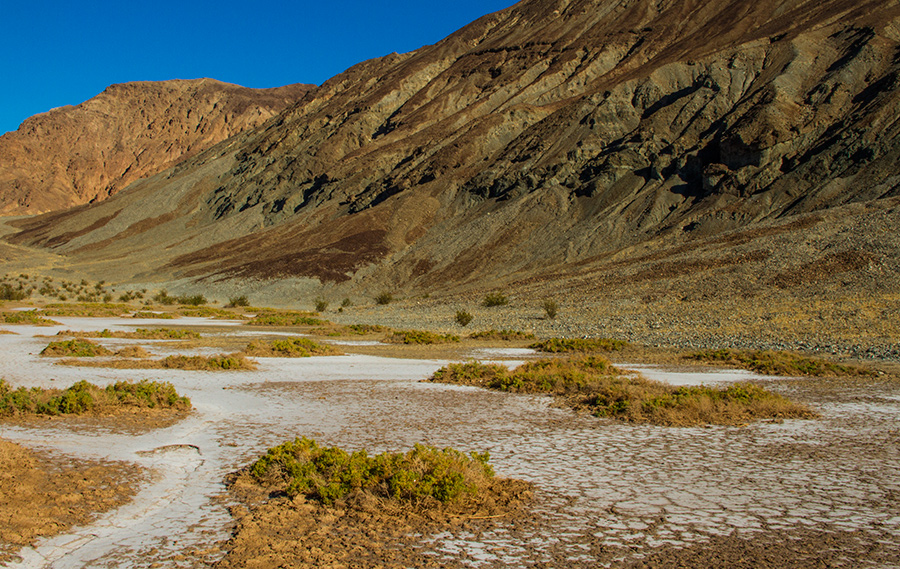
More salt
This heating and rising process is different in Death Valley due to the surrounding mountains as they provide its specific climate. Mountains surround the valley, while its surface is mostly flat and devoid of plants, so much of the sun's heat can reach the ground, absorbed by soil and rock. When air at ground level is heated, it begins to rise, moving upward past steep, high mountain slopes. The air cools slightly, but can't clear the mountaintops. It sinks back down towards the valley more compressed. This air is then reheated by the next day's sun to a higher temperature and at night it moves part way up the mountains again. This cycle of sinking and rising heated air increases the ground temperature markedly, forming the hot wind currents that are trapped by atmospheric pressure and the surrounding mountains, therefore trapping the heated air and hot wind currents mostly within the valley. Such hot wind currents contribute to perpetual drought-like conditions in Death Valley and prevent much cloud formation from passing through the confines of the valley, where precipitation is often in the form of a virgra, which is rain that evaporates before it reaches the ground. Death Valley holds temperature records because it has an unusually high number of factors that lead to high atmospheric temperatures.
The depth and shape of Death Valley influence its summer temperatures. The valley is a long, narrow basin 282 feet below sea level, and is walled in by high, steep mountains. The clear, dry air, extremely low humidity, and sparse plant cover allow sunlight to heat the desert surface. Summer nights provide little relief, as overnight lows may only dip into the 82 to 98 °F range. Super-heated air flowing through the valley creates extremely high temperatures resulting in the world record of 134 degrees recorded at Furnace Creek on July 10th 1913 and a ground surface temperature of 201 degrees on July 15th, 1972 also at Furnace Creek.
FLORA and FAUNA
Death Valley consists of a remarkable variety of geographic features such as high altitude desert, mountains, salt flats, and lowland desert that descends to 282 feet below see level.
The northern border is high desert and follows the Cucamonga Canyon. The remote mountainous area is home to a thriving and often garish looking Joshua trees.
In the lowest valley elevations where the soil is predominantly saline due to the heat driven rapid evaporation, lives salt grass, pickle weed, greasewood, iodine bush and honeysweet.
As the elevation rises plant life changes to suit the changes in soil composition. There we find the creosote bush, arrowweed, burrobush, and brittlebush and desert holly. Beavertail and barrel cactus are common with eye-catching flowers.
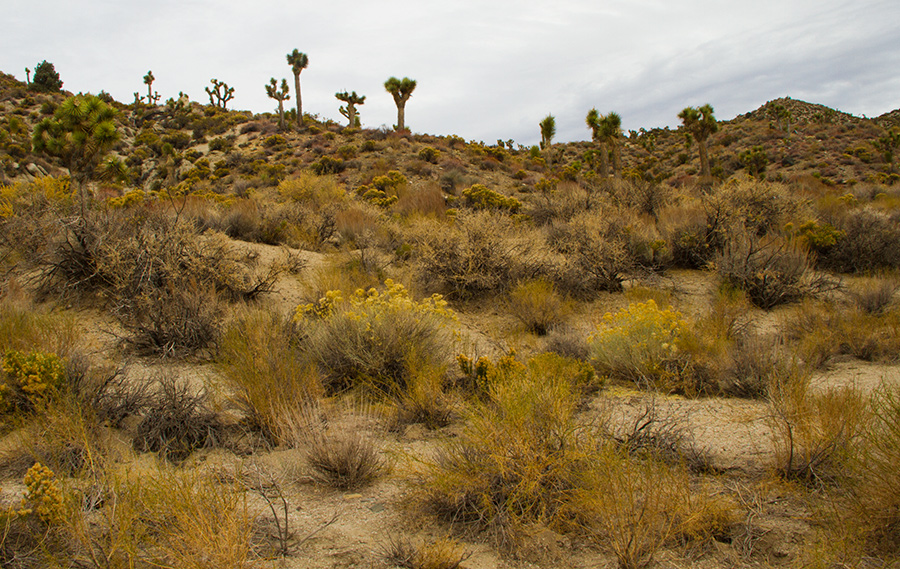
Mixed vegetation
The tamarisk tree, also known as salt cedar, grows to 40 feet high. It has become an invasive non-native species. It was introduced to provide windbreaks and shade. However the roots are incredibly thirsty and are rapidly depleting the groundwater. A removal program has been necessary in some areas where the trees have caused damage.
At least 400 animal species have adapted to Death Valley's harsh environment. An example of extreme adaptation is the kangaroo rat that has developed a system that requires no free water and along with some birds and reptiles they retain water from their urine and produce almost solid waste. Burrowing animals emerge after dark to escape the daytime heat.
Black-tailed jackrabbits (they are really hares as they are born with eyes open and fully furred ready to run) are often seen bounding across the desert. Coyotes are fairly common and dig down to find water below the earth's surface. These holes also provide water for other non-digging species. The long eared nocturnal kit fox will steal any food left outside a tent at night.
Mountain lions, bobcats, and big horn sheep make their home in the higher altitudes.
Wild burros, left by early explorers and miners have increased in numbers to become a nuisance. They eat the vegetation and deplete the meager water sources that native mammal species and birds depend on for survival. A round-up and removal program has been enforced.
Ravens, bold and curious, inhabit Death Valley along with the red-tailed hawk. Roadrunners, a member of the cuckoo family, are the most famous and beloved bird of the desert. Anyone lucky enough to see a roadrunner is in for a comical show. An attempt to follow their tracks can be frustrating as the tracks appear to be going in both directions at once due to two long toes pointing forward and a second similar pair pointing backwards.
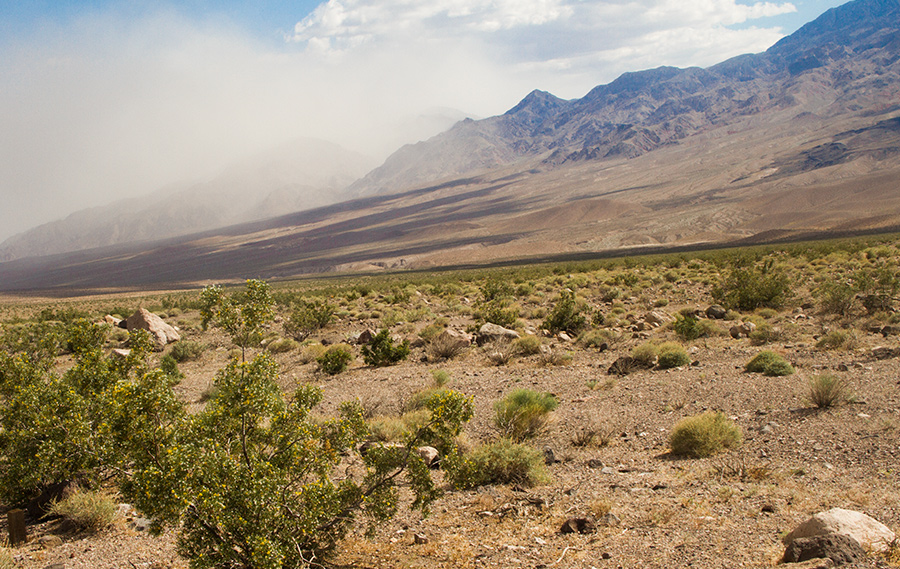
Dust storm in the distance
The desert tortoise and several species of lizard and snakes live in Death Valley. The venom of the Mojave rattlesnake, also called the Mojave green is considered to be the most toxic of any snake in North America. They are most often found in the under growth around mesquite and creosote bushes.
HISTORY
Death Valley National Park straddles the California-Nevada border, east of the Sierra Nevada border.
Death Valley is home to the Timbisha tribe of Native Americans formerly known as the Panamint Shoshone, who have inhabited the valley for at least the past millennium. The Timbisha name for the valley, tümpisa, means "rock paint" and refers to the red ochre paint that can be made from a type of clay found in the valley. Some families still live in the valley at Furnace Creek. Another village was in Grapevine Canyon near the present site of Scotty's Castle. It was called in the Timbisha language, maahunu, whose meaning is uncertain, although it is known that hunu means "canyon".
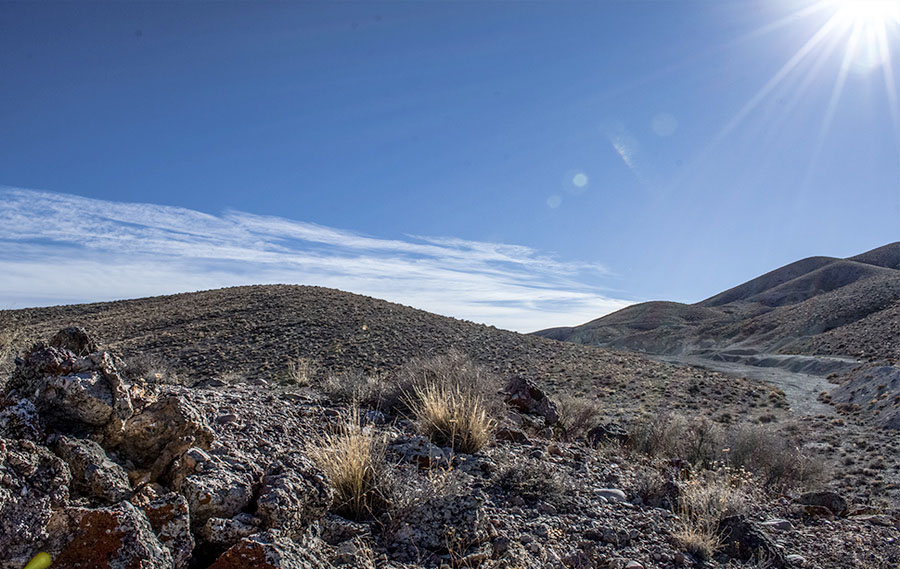
Gravel presents more challenging passage
A group of European-Americans, trapped in the valley in 1849 while looking for a shortcut to the gold fields of California gave the valley its name, even though only one of their group died there. Several short-lived boomtowns sprang up during the late 19th and early 20th centuries to mine gold and silver.
The only long-term profitable ore to be mined was the borax that was transported out of the valley with twenty-mule teams. The valley later became the subject of books, radio programs, television series, and movies. Tourism expanded in the 1920s when resorts were built around Stovepipe Wells and Furnace Creek.
Known as a prosperous mining Mecca for many decades, the valley was mined extensively for gold, silver, copper, tungsten, lead, zinc, antimony, and borax. The last mining operation, the Billie Mine, ceased operations in 2005. There still exist many abandoned mines scattered throughout the Park.
From the spectacular wildflower blooms in spring, the Joshua trees growing at higher elevations, to the fascination of ghost towns, historic mining operations, wildlife, and natural raw beauty, Death Valley National Park draws visitors from all over the world.
The International Dark Sky Association designated Death Valley National Park as a Dark Sky Park 2013.
Helen Describes Her Death Valley Crossing [Page One]
Back to [National Parks Index]
